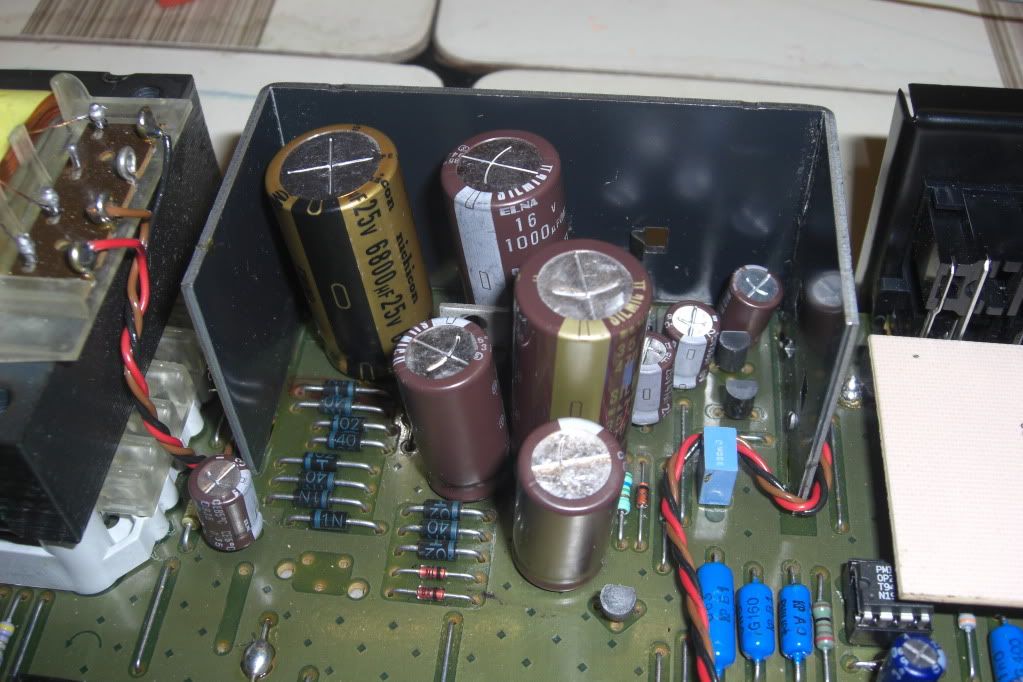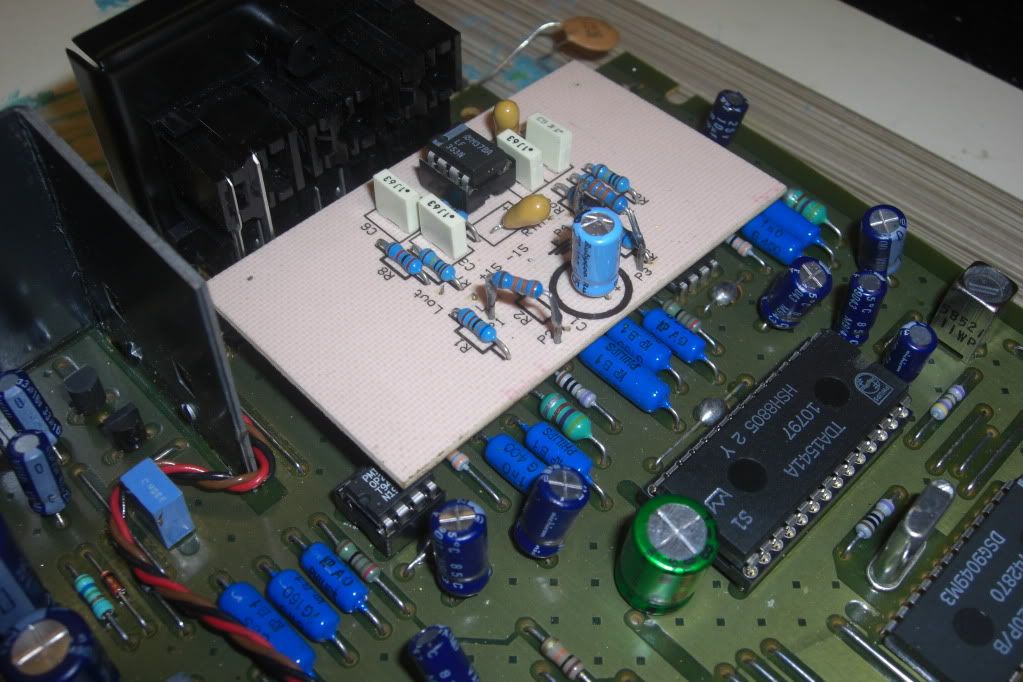If you are going to keep the player it's well worth doing. It is the little differences that add up 🙂
after all the fault finding, its staying, its part of the family now.....😉
Okay, first of the mods done, power supply caps replaced with Silmic IIs (Elna) some of them a very tight squeeze indeed 😱
Also got the Opamps ready to replace by putting chip holders in, so as soon as them come they can be easily installed, although one was very tricky to access, here are some pics for you 😀

old caps

new LARGE Elnas
and one Nichicon


both op amps, see the access of the one below the raised PCB
Also got the Opamps ready to replace by putting chip holders in, so as soon as them come they can be easily installed, although one was very tricky to access, here are some pics for you 😀

old caps

new LARGE Elnas
and one Nichicon


both op amps, see the access of the one below the raised PCB

well had a good listen, and even changing the caps has made an AMAZING difference, everything has been tightened up, and the voices leap from the speakers, do you think that its work replacing all the electrolits in the machine?
Well now to wait for the OPAMPS to arrive. I can see that this is going to be very addictive indeed, its like a new machine.
Well now to wait for the OPAMPS to arrive. I can see that this is going to be very addictive indeed, its like a new machine.
A word of caution.
Although changing all the caps is worthwhile due to their age, I would advise keeping the same values especially in the servo and RF stages. Some do not respond well to increases in value.
Andy
.
Although changing all the caps is worthwhile due to their age, I would advise keeping the same values especially in the servo and RF stages. Some do not respond well to increases in value.
Andy
.
If you are very careful it might be worth replacing the electroylitics, no others though.
As Andy says, stick to the original values, and as I say 🙂 stick to the original physical size too.
When you remove the opamps from the sockets lever each end a little at a time... don't use fingers or it will come out with a jerk, bend the pins, and probably embed itself in your finger.
Also I don't kwow what the wiring is like but Philips used single core wire to make up all the looms, and it's fragile, so be careful with all the plugs and sockets.
Edit... on the extra PCB seems like two 33K resistors have been tagged on or are a select on test item. Seems unusual for a simple opamp based gain/filter stage.
As Andy says, stick to the original values, and as I say 🙂 stick to the original physical size too.
When you remove the opamps from the sockets lever each end a little at a time... don't use fingers or it will come out with a jerk, bend the pins, and probably embed itself in your finger.
Also I don't kwow what the wiring is like but Philips used single core wire to make up all the looms, and it's fragile, so be careful with all the plugs and sockets.
Edit... on the extra PCB seems like two 33K resistors have been tagged on or are a select on test item. Seems unusual for a simple opamp based gain/filter stage.
Last edited:
don't use fingers or it will come out with a jerk, bend the pins, and probably embed itself in your finger.
ouch !
🙂
oh bugger, I have just spotted another opamp, cant believe that I missed it, its underneath the floating circuit, to the RHS, and I have only ordered two of the OP2604, DOH!!!
see the third pic down, sneakly little bugger.
see the third pic down, sneakly little bugger.
is that right for it to have 3 opamps? two on the main board and one on the floating board, might order one LM4562
🙂
Is it right for it to have 3 opamps... that sounds so funny.
Before you go ordering something different... what is that opamp number ?
You can mix and match opamps as mentioned before, but what if one is left channel and one is right... which is likely. You don't want different devices in each.
The one on the add on PCB is obviously used for L and R
What I would do is fit the OPA2604's for two underneath... depending on just what that other one is of course... keep the LF353 where it is for now and have a listen.
Is it right for it to have 3 opamps... that sounds so funny.
Before you go ordering something different... what is that opamp number ?
You can mix and match opamps as mentioned before, but what if one is left channel and one is right... which is likely. You don't want different devices in each.
The one on the add on PCB is obviously used for L and R
What I would do is fit the OPA2604's for two underneath... depending on just what that other one is of course... keep the LF353 where it is for now and have a listen.
🙂
Is it right for it to have 3 opamps... that sounds so funny.
Before you go ordering something different... what is that opamp number ?
You can mix and match opamps as mentioned before, but what if one is left channel and one is right... which is likely. You don't want different devices in each.
The one on the add on PCB is obviously used for L and R
What I would do is fit the OPA2604's for two underneath... depending on just what that other one is of course... keep the LF353 where it is for now and have a listen.
I think that you are right, the Opamps on the PCB are both the same, bit embarrassed that I missed it, its so close to the other one, as you say I would presume that these are left and right channels.
😱
🙂
Esy way to tell... with the thing playing at low volume touch pins 2 and 3 and pins 5 and 6 with a metallic screwdriver... don't short to anything, just touch.
If you hear the clicks in just one channel for each then obviously that opamp is for that channel. If the clicks are say left channel for pins 2 and 3 and right channel for 5 and 6 then the opamp is shared and you can "mix and match"
Does that make sense ?
If you hear the clicks in just one channel for each then obviously that opamp is for that channel. If the clicks are say left channel for pins 2 and 3 and right channel for 5 and 6 then the opamp is shared and you can "mix and match"
Does that make sense ?
And just to be clear 🙂 I don't mean shorting pins 2 and 3 etc, just touching each in turn. These are the -/+ inputs for each opamp. You may find only one of the two gives a response. If you look at the data sheet and pinouts it will be clear. Sometimes one pin is grounded anyway so you wouldn't hear anything of course.
It should be fairly simple to distinguish between the two, but sometimes op amps are used to drive the linear servo (the lens) or some other motor (door, sled, spindle), and not necessarily sound amplification. This could explain some "additional" op-amps present in the CD player.
Of course if this is the case, it's definitely not an amp you want to switch with a "good sound" amp like opa2604 or lm4562.
Of course if this is the case, it's definitely not an amp you want to switch with a "good sound" amp like opa2604 or lm4562.
Esy way to tell... with the thing playing at low volume touch pins 2 and 3 and pins 5 and 6 with a metallic screwdriver... don't short to anything, just touch.
If you hear the clicks in just one channel for each then obviously that opamp is for that channel. If the clicks are say left channel for pins 2 and 3 and right channel for 5 and 6 then the opamp is shared and you can "mix and match"
Does that make sense ?
perfect, will give that a try.
It should be fairly simple to distinguish between the two, but sometimes op amps are used to drive the linear servo (the lens) or some other motor (door, sled, spindle), and not necessarily sound amplification. This could explain some "additional" op-amps present in the CD player.
Of course if this is the case, it's definitely not an amp you want to switch with a "good sound" amp like opa2604 or lm4562.
Good point, my only thinking that they are all for output stage is that they are in the same area, I presume that is logical, you guys know more than me obviously, but I am guessing that is so 😕
I know its guessing, but logic states that the two are left and right, and the one on top??
that circuit board does have 'Orelle' written on it, so its obviosuly a mod from the philips board, does it mean that possibly the chip on its own is running both chanels?
why would that be do you think?
Just out of interest really.
that circuit board does have 'Orelle' written on it, so its obviosuly a mod from the philips board, does it mean that possibly the chip on its own is running both chanels?
why would that be do you think?
Just out of interest really.
- Status
- Not open for further replies.
- Home
- Source & Line
- Digital Source
- CD player with distortion. laser?